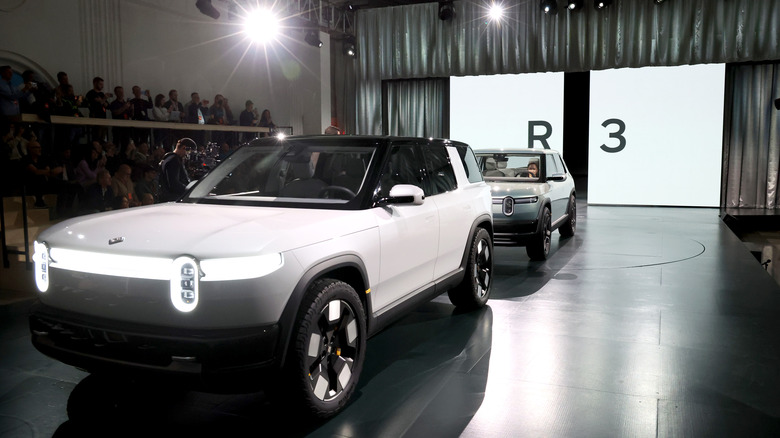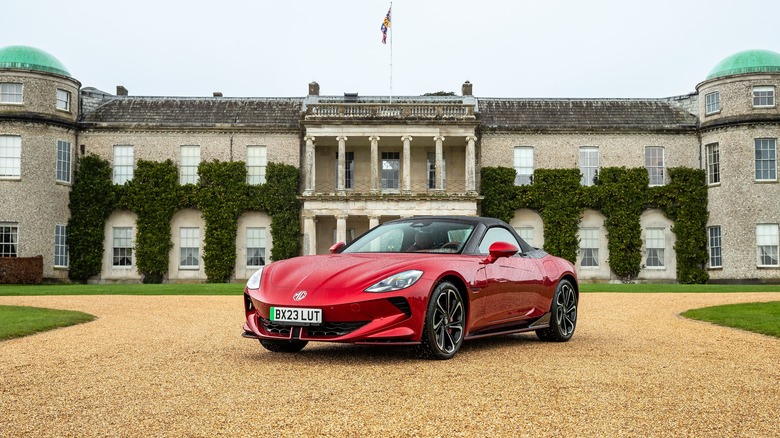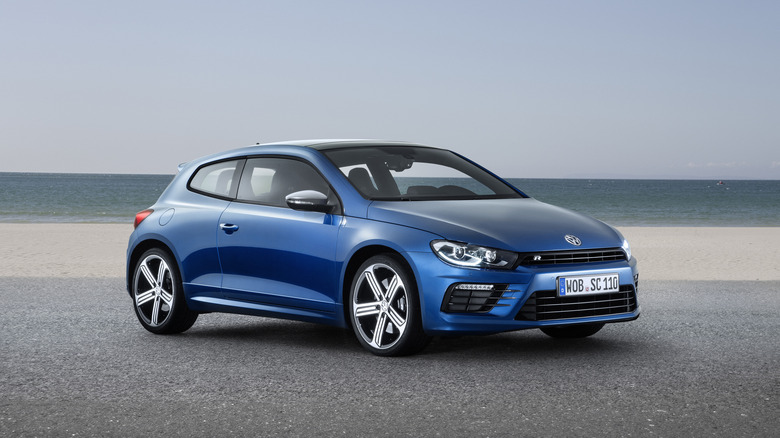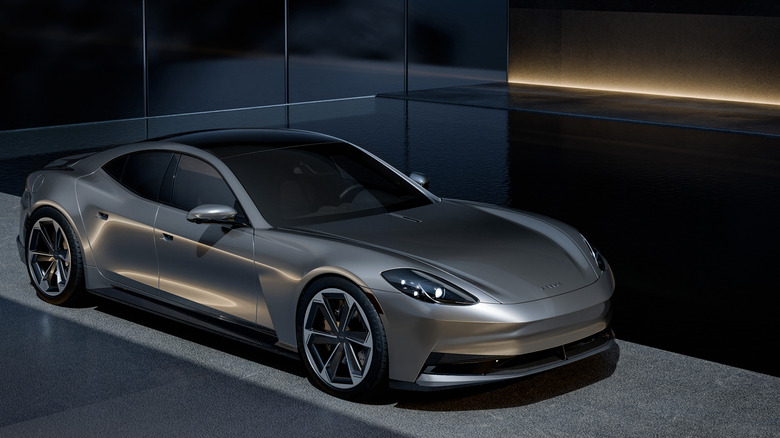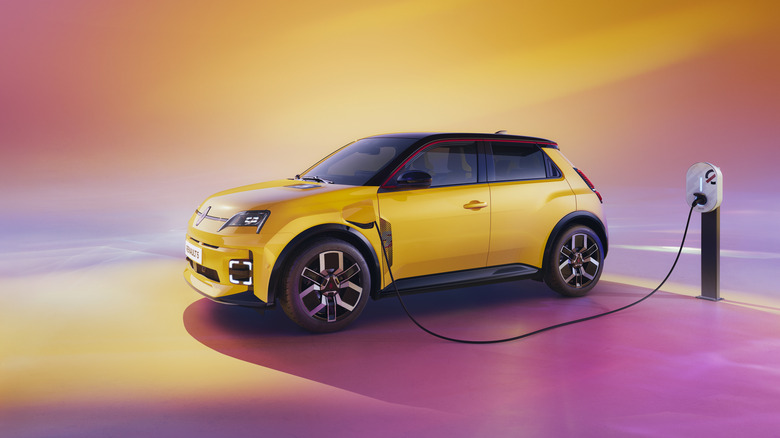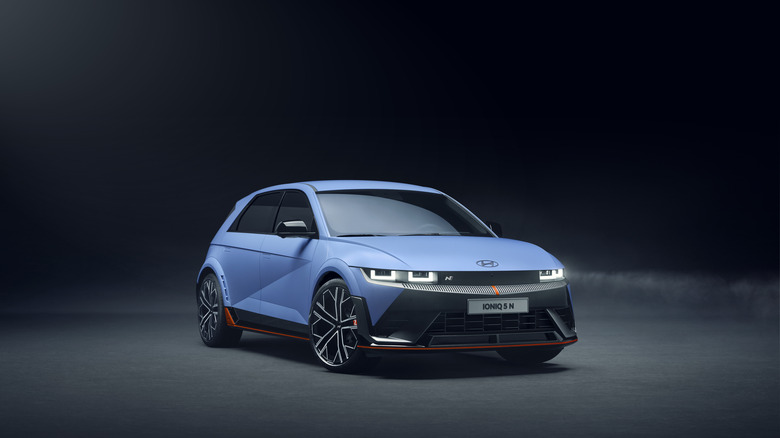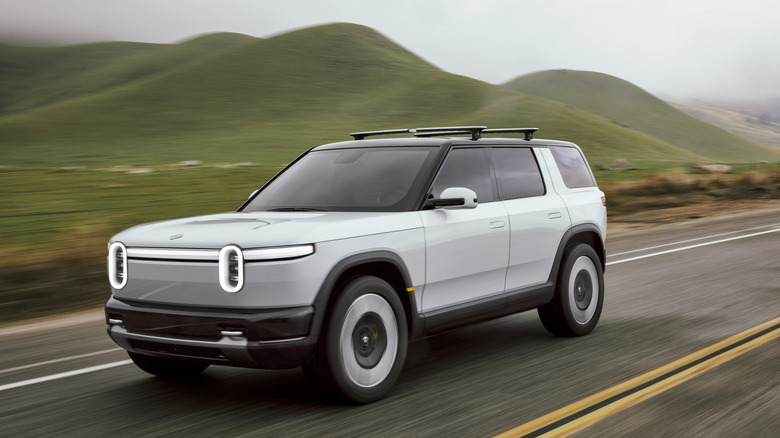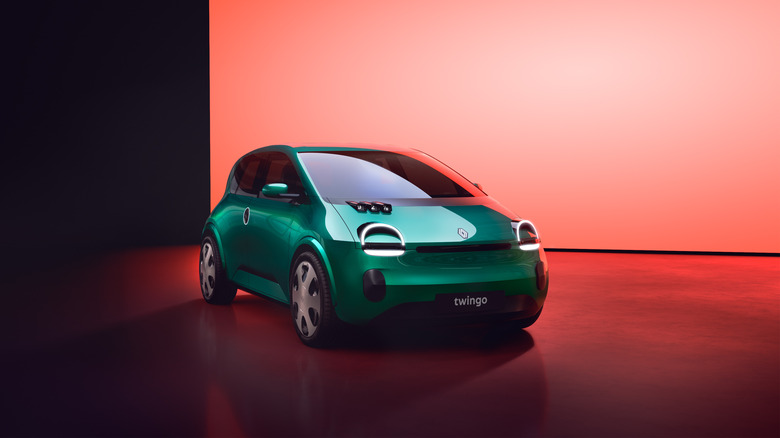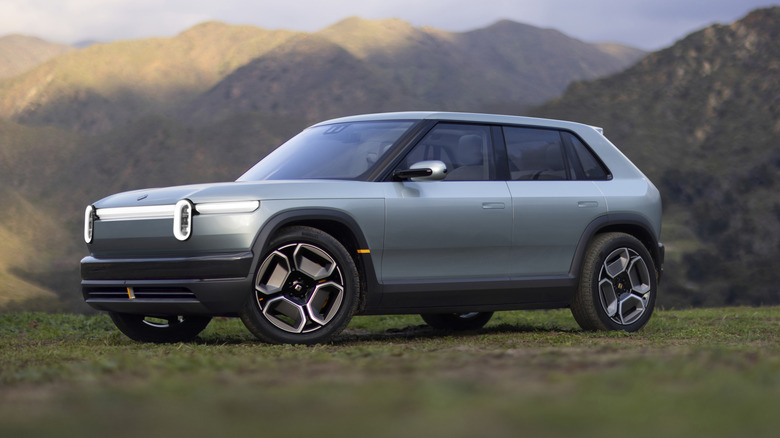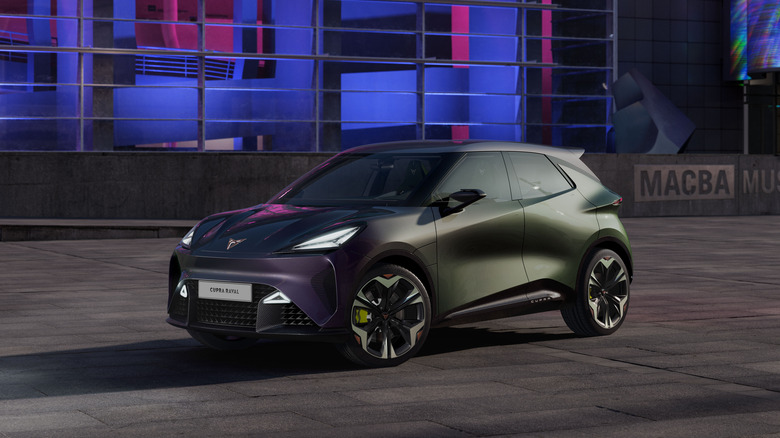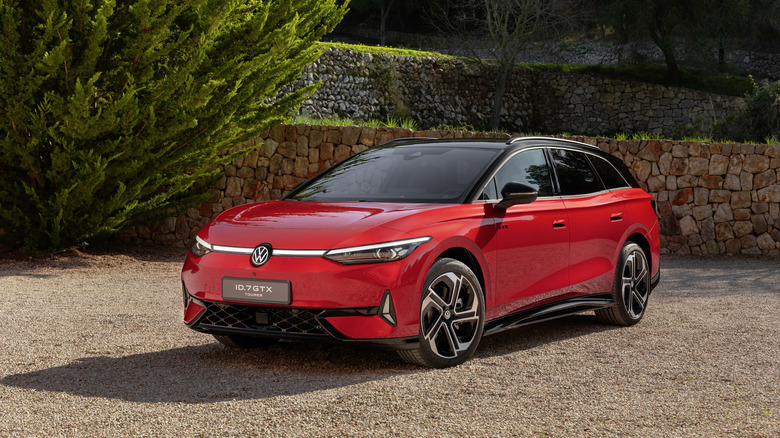10 Awesome New Electric Cars We're Looking Forward To
Very few conversations about the current automotive climate can go by without mentioning electric cars. Automakers are pushing heavily for an all-electric future, despite a lot of car enthusiasts being vocal about their dislike of anything on four wheels powered by batteries. We're prepared to concede to some extent that some EVs aren't really worth getting excited over, though a lot of criticism seems to come from common electric vehicle myths people should stop believing.
The electric car revolution has brought along quite a few merits. For one, tasteful retro styling has made a bold comeback. With the right amount of horsepower, EVs also tend to be much more performant than their ICE counterparts, and their scalable platforms allow for much more spacious interiors. Electric motors are also capable of doing things that ICEs aren't. When you combine these aspects, it makes for some truly exciting electric cars that we can't help but look forward to.
MG Cyberster
One of the coolest names for such a cool car. While the MG of today has nothing in common with what most people know as MG other than the name, the company is drawing inspiration from some of the best MG cars ever made and combining it with battery power, for some pretty exciting results. The new Cyberster is one of the first cars of its kind: a fully-electric two-seat roadster that's a lovesong to the cult classic MGB.
The Cyberster is available in RWD or AWD form, with either one motor at the rear axle or one motor for each axle. The dual-motor AWD version puts out a pretty hefty 536 hp and 535 lb-ft of torque, and allows the Cyberster to accelerate to 60 mph in just 3.2 seconds. Those are some pretty impressive figures, especially considering that despite the Cyberster's Miata-esque dimensions, it weighs over 4,000 lbs.
That's the slightly unfortunate reality of electric power. Purists who have owned 10 MGBs and Austin Healeys will undoubtedly be keen to point out that the driving experience will be ruined by that weight figure. However, a 4,000-lb EV and a 4,000-lb combustion-engined car aren't quite the same, and we're confident that MG has found a way to mitigate the Cyberster's seemingly porky weight figure. The Cyberster also brings drama to the table with butterfly doors, arrow-shaped rear turn signals, and a futuristic, cyberpunk design language.
Volkswagen Scirocco (Rumored)
One of the most popular trends in the auto industry since the electric revolution started has been reviving iconic nameplates as new battery-powered models. For better, and for worse. Volkswagen has already started doing this, in a roundabout way, with the ID.Buzz. The revival of the iconic Type 2 Bus has gone over well with most people, and if the rumors are anything to be believed, another legendary VW model is about to come back as an EV: the Scirocco.
The rumor mill has spun periodically about this one for quite a while, and now, once again, it has started back up. Every generation of the Scirocco has shared its underpinnings with other VW models in the lineup, notably the Golf and the Passat. That was also true of the most recent generation, which unfortunately bowed out in 2017. This Scirocco will be very different from previous generations, however.
If VW decides to put together an electric Scirocco, it won't be based on the MEB platform that currently underpins the majority of EVs from VAG's other non-luxury brands. The rumors claim that the next Scirocco will be based on the same underpinnings as the upcoming electric Porsche 718. This sounds fantastic, but obviously, it should be taken with a grain of salt. Come on, VW. Do it.
Karma Gyesera
Do you remember the Fisker Karma? More than a decade ago, an automotive company called Fisker launched a 400 hp plug-in hybrid luxury sedan with, to this day, some of the wildest styling we've seen on a production car. Nowadays, the Fisker Karma is known for being a failure, for catching fire, and also for being the product of a company that somehow continuously manages to cheat death, even after bankruptcy and more than a decade. The Fisker brand may still exist (and be headed for trouble once again), but the company that formed from its assets in 2014, Karma Automotive is about to launch its new car: the bizarrely named Gyesera.
Despite featuring all-new styling, it still resembles the Karma quite heavily, which means it also resembles Karma Automotive's previous attempt at reviving the original Karma, the Revero. Unlike the Revero, however, the Gyesera is fully electric and doesn't feature any sort of hybrid component. The resemblance to the original Karma is absolutely not a bad thing, as it still looks just as wild as ever.
A 120 kWh battery pack juices the Gyesera, promising a range of over 250 miles. It also promises 590 hp and 693 lb-ft of torque, a 0-60 time of around four seconds, and a top speed higher than 135 mph. We can hear Tesla fans laughing maniacally, but if Karma manages to get the drivetrain setup just right, this could be quite a special car. You've probably never seen the word "karma" so many times in one place.
Renault 5 E-Tech Electric
The Renault Group has been experimenting with electric cars for more than a decade now. When you're messing around with EVs for such a long time, you learn a lot of things along the way. The new Renault 5 E-Tech Electric shows that Renault's vision of the future is compact electric cars that don't weigh 500 tons and have 200 million horsepower. This is one of three upcoming retro EVs from the automaker, the others being revivals of the Renault 4 and the original Twingo.
Slotting below the Megane E-Tech in the lineup, the new Renault 5 uses the CMF B-EV platform, also known as the AmpR Small platform. This will also underpin the upcoming Renault 4 EV, and the Nissan Micra EV. All of that is wrapped up in an adorable exterior that pays tribute to the original Renault 5 from the 70s and 80s, and one of the last cars the French automaker offered to Americans, badged as Le Car.
The tiny dimensions mean the Renault 5 weighs close to nothing by EV standards, and it can achieve up to 248 miles of range — plenty for people who have a primarily urban commute. Thanks to the benefits of electric car platforms and a super long wheelbase, it shouldn't sacrifice any interior room either. Another fine example of the booming return of retro styling to the automotive industry, right up there with the Hyundai Ioniq 5.
Hyundai Ioniq 5 N
Ever since the Hyundai Ioniq 5 debuted back in 2021, it has quickly become one of the world's favorite electric cars. It seemingly can't stop winning awards and for good reason: It's a fantastic all-round electric car, and really, there are only a handful of things it can't do. One of the more notable ones is outaccelerate sports cars, but with the Ioniq 5 N, that's now possible.
The Ioniq 5 N is the first fully electric car from the Hyundai N division. It's impressive how little time it took the N division to steal the crown from the hot hatch titans, and it's a shame that the gas-powered ones will soon be discontinued. However, if the Ioniq 5 N is anything to go by, things are about to get a whole lot more exciting.
Based on the dual-motor, AWD version of the Ioniq 5, the N version puts out a colossal maximum of 641 hp when you activate the unfortunately named N Grin Boost. Otherwise, it makes a modest 601 hp. It also includes a drift mode, and a claimed 0-60 time of 3.2 seconds. The top speed is limited to 162 mph. It also features simulated paddle-shifting, as well as a synthesized turbo four-banger sound, something the internet loves to mercilessly mock. However, after our first drive with the 2025 Hyundai Ioniq 5 N, it seems like it will be having the last laugh.
Rivian R2
For quite a while, it seemed like Rivian's fortunes were in dire straights. Then, the automaker dropped a massive bombshell, and things are finally looking up. The R1T and R1S can be considered boutique EVs, as they're quite expensive and niche in a lot of ways. The newly revealed R2 is Rivian's pivotal electric SUV for the masses. Although it's smaller and cheaper than its larger cousins, this car still carries the same distinctive design language.
The R2 rides on an all-new platform, though that doesn't mean it won't carry on the automaker's core values. Despite its smaller dimensions and lack of third-row seating, the R2 is still aimed at adventurous types. Rivian says the new R2 will start at around $45,000, and it'll go on sale at some point in 2027. That's quite a long wait, but it could be worth it.
With a promised 300 miles of range and a 0-60 time of around 3 seconds, the R2 will also be just as fast as the most powerful versions of the R1T and R1S. Considering that those two wowed just about everyone with their admirable competence at basically everything, distilling all those qualities into a smaller and more affordable package is the way to go. The R2 is looking fantastic, and it's not even the most exciting upcoming product from Rivian.
Renault Twingo
Only a handful of cars throughout history can pride themselves in kickstarting a design revolution, and that's certainly the case with the original Renault Twingo. Designed to replace the aging R4, the original Twingo made the world fall back in love with ultra-compact, ultra-affordable cars with cutesy designs. The first Twingo is a cult classic now, and Renault clearly recognizes this, which is why it's bringing it back as a super affordable electric car in 2026.
While the Twingo has been a part of Renault's lineup since 1992, the new electric Twingo will give the original car's brilliant styling a modern twist. As well as the cute round headlights and friendly face, the new electric Twingo will also bring out a familiar exterior trait from the original car: the three fresh air vents. Except here, they show the battery percentage. Genius!
The Twingo will be a part of Renault's upcoming lineup of affordable compact EVs. It will likely sit on the AmpR Small platform, and a production model is on the cards for 2026. The new Twingo will also add rear doors, something the original lacked, which means it should be pretty spacious inside too. With this styling, it's an instant winner.
Rivian R3
Alongside the R2, Rivian also dropped a massive bombshell in the form of the R3. Almost immediately, this tiny crossover garnered a whole lot of attention, for all the right reasons. Even though Rivian is calling it a crossover, the design has the air of the 1980s about it — evoking cars like Lancia Delta Integrale, Renault 5, Fiat 127, you name it. It's very difficult to deny Rivian absolutely nailed the look of the R3.
Of course, that's not all. The R3 will also be available with either one, two, or three electric motors, as well as two different battery pack sizes. There will also be a performance-oriented R3X which will come standard with three motors. Hopefully, it'll put on its best Lancia Delta Integrale and MG Metro 6R4 impression when you take it out on a dirt track.
Details for the R3 are scarce at the moment, except that it'll go on sale at some point in 2027 with prices floating around the $40,000 mark. Car enthusiasts the world over are pretty fatigued with electric crossovers right now, but the Rivian R3 seems to be a totally different take on it. On paper at least, it has all the right ingredients to stir the soul.
Cupra Raval
The Volkswagen Group is very in on electric cars, and they already have a whole host of models in a majority of market segments. The ID.4 and its siblings are compact crossovers, the ID.3 is for the hatchback buyers, and so on. However, the group is now preparing to enter what could become the hottest EV sub-segment: tiny cars. On paper, the most exciting of all the upcoming tiny VAG EVs comes from Cupra, the performance arm of Spanish automaker Seat. They call it the Raval.
Previewed as the wild, race-inspired UrbanRebel electric car concept a few years ago, the Raval will share its underpinnings with Volkswagen's own upcoming ID.2, as well as the upcoming Skoda Epiq. In the looks department, Cupra has prioritized a fun, angular design guaranteed to turn some heads. We don't know if the resplendent paint finish will reach production, but we really hope it does.
The Raval will enter into battle with the likes of the Renault 5 E-Tech and the upcoming Renault Twingo when it reaches production in 2025. Cupra promises up to 225 hp and over 270 miles of range. Assembly will take place in Martorell, Spain, and according to Cupra, this EV will introduce the next generation of buyers to battery-powered automobiles, and make them accessible to a wider demographic.
Volkswagen ID.7 GTX Tourer
Despite electric cars taking on all sorts of different forms, there is a distinct lack of EVs in one highly beloved automotive segment: the station wagon. Thankfully, that seems to be changing, with more and more automakers exploring the possibilities of an electric wagon. One of the latest to dip its toes into this pool is Volkswagen with the new ID.7 Tourer. Under most circumstances, it's just a wagon version of the Model 3-rivaling ID.7 sedan, but the GTX version is a little more special.
The slight differences on the outside give a clue as to what the GTX is all about. A dual-motor setup and AWD are both standard. And thanks to a larger 86 kWh battery pack, the ID.7 GTX Tourer puts out 335 hp, which is a slight increase over the most powerful ID.7 variant. Towing capacity also jumps up to 1.4 tons, or just under 3,100 lbs. That's pretty impressive, though we'd imagine the range will suffer.
You also have a temporary maximum power mode like a lot of other EVs, called GTX Punch here. The ID.7 GTX Tourer is a cautious display of what happens when you pair a fast wagon with electric power. It's not a rocket ship, and it's almost certainly not coming to North America, but we admire VW's belief in the electric wagon, as well as the decision to sprinkle it with a bit of extra performance and better dynamics.
